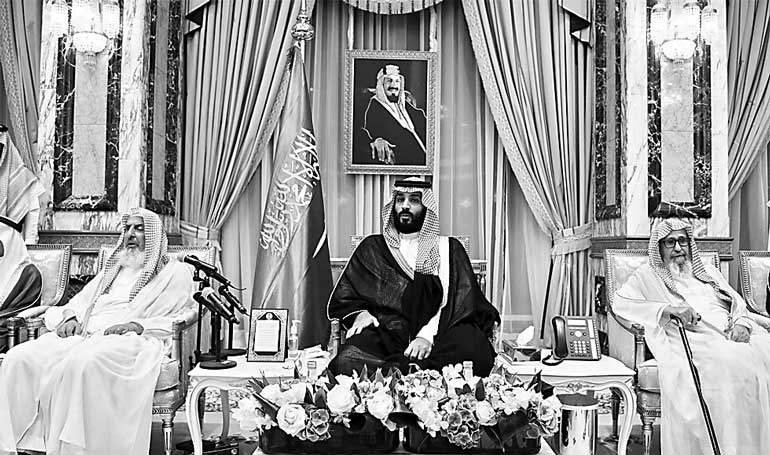Monday Nov 24, 2025
Monday Nov 24, 2025
Saturday, 24 June 2017 00:00 - - {{hitsCtrl.values.hits}}
 Saudi Arabia’s Crown Prince Mohammed bin Salman sits during an allegiance pledging ceremony in Mecca, Saudi Arabia June 21, 2017. Bandar Algaloud/Courtesy of Saudi Royal Court/Handout via REUTERS
Saudi Arabia’s Crown Prince Mohammed bin Salman sits during an allegiance pledging ceremony in Mecca, Saudi Arabia June 21, 2017. Bandar Algaloud/Courtesy of Saudi Royal Court/Handout via REUTERS
Reuters: The elevation of Mohammed bin Salman as Crown Prince of Saudi Arabia has ended two years of speculation about a behind-the-scenes rivalry near the pinnacle of royal power, but he still has to win over powerful relatives, clerics and tribesmen.
The 31-year-old favoured son of King Salman was already in effect the day-to-day ruler, with sweeping powers over defence, energy and the economy, even though his cousin Prince Mohammed bin Nayef, 57, occupied the more senior job as crown prince.
For two years the meteoric rise of Mohammed bin Salman stirred talk of strains and competition between the two princes, both known by their initials as MbS and MbN.
That all ended on Wednesday when the Al Saud family publicly closed ranks around MbS following his sudden elevation by royal decree. MbN, stripped both of his rank as heir and his position as the veteran head of Saudi Arabia’s internal security forces, was among the first to pledge allegiance to his newly elevated younger cousin.
And yet questions remain over how the youthful MbS will consolidate his own network of power and patronage.
Any jostling for power among the hereditary lines of state founder King Abdulaziz al-Saud is carefully hidden behind the ornate doors of royal palaces. Princes are keen to avoid a full-blown internal struggle of the kind that brought down two previous Saudi dynasties in the 18th and 19th centuries.
“We know there’s grumbling, we know there is unhappiness but so far everybody’s lined up,” said Gregory Gause, Gulf expert at Texas A&M University. He added that he did see not any evidence yet of a family “crisis”.
Abdulaziz, who founded the Saudi state in 1932 after conquering most of the Arabian peninsula, had at least 45 sons, of whom 36 survived into adulthood. Since he died in 1953, the country has been ruled successively by six of them.
The next king will be the first from the next generation, and there are no formal rules for how to pick a successor from among Abdulaziz’s scores of grandsons.
The reshuffle has sparked speculation of late that the octogenarian King Salman could abdicate in favour of his son to ensure the first generational succession in 64 years takes place without a fight.
“There is a very high probability that the king wants to oversee the transition while he is still alive. A big plan of transition is being put in place,” said Mamoun Fandy, a London-based analyst of Arab politics.
Moving MbN out of the line of succession sidelines the most powerful member of one of the most powerful lines: the sons of King Salman’s older brother Nayef, who ran Saudi Arabia’s internal security forces for decades as interior minister, and was crown prince when he died in 2012.
MbN’s successor as interior minister is a 33-year-old grandson of Nayef, keeping the internal security forces in the hands of the Nayef line. But with little government experience and few personal networks to call on, the new minister will probably remain beholden to the king and crown prince, analysts say.
Other princes that might once have been seen as contenders include Miteb bin Abdullah, a son of the last king; Khalid bin Sultan, a son of a former crown prince; or Muqrin bin Abdulaziz, the youngest surviving prince of Salman’s own generation, deposed as crown prince in 2015.
But any rival’s path to bid for the throne is more difficult now that MbN has accepted MbS’s ascension.